Game Guide and Troubleshooting
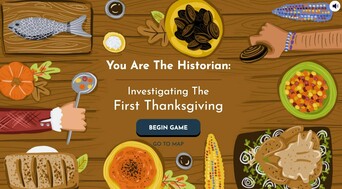
How to Play
Goal
Successfully complete four challenges to collect information for a school newspaper article. Discover the people, places, artifacts, ideas and events that led up the 1621 harvest celebration known today as “the First Thanksgiving.”
Gameplay
Choose from four locations where key events leading up to the 1621 harvest celebration happened.
Complete a primary source challenge at each location to unlock key information for your article.
Collect all four passwords to publish your article and unlock the secret location!
Before Teaching the Game
Use this guide and play the game through a few times to familiarize yourself with the content and mechanics.
Setting up your Classroom
Students can play individually (to learn at their own pace) or in pairs (to encourage discussion and teamwork). Students should use headphones to take advantage of the game audio.
Play the game as a whole class activity by projecting it onto a screen or whiteboard. Include as many students as possible in decision making without slowing down the game play.
Assign the game as homework. Introduce the game in class and ask students to complete the entire game or a certain number of challenges at home.
Introduce the Game
The game includes basic instruction of the story, rules, and game mechanics. For the best experience, provide a verbal preview of the game and play through one module together so the students know how the game works.
Facilitating Gameplay
If students are working independently or in pairs, circulate and check on progress. Be mindful of students having trouble either with the game content or the mechanics.
Some teachers encourage students who have mastered the mechanics to be a “consultant” and support other students who may be struggling.
Encourage feedback and reflection. Discussion questions and suggested activities are available in the accompanying You are the Historian Teacher Toolkit.
Learning Outcomes
Students will:
Compare and contrast Wampanoag and 17th-century colonial English artifacts to explore how people lived day-to-day
Define “archaeology” and explain how archaeologists learn about the past
Understand how Wampanoag culture transformed over time by sorting artifacts by date
Examine eyewitness accounts of the establishment of a mutual alliance between Plymouth Colony and the Pokanoket Wampanoag as well as the 1621 harvest feast now called the First Thanksgiving
Answer questions to demonstrate understanding of a text
Describe the relationship between a series of historical events
Use data to answer questions and solve problems
Cultivate respect and historical empathy
Evaluate information and make reasoned judgements based on evidence to sort objects by cultural origin
Progress cannot be saved; however, if you want to resume play where you left off, use the map icon to go to that location to resume play.
Yes, You are the Historian can be used on tablets! It will not work on smartphones.
Each activity takes approximately 10-20 minutes to complete. The whole game takes 40-60 minutes to complete.
You are the Historian: Investigating the First Thanksgiving is a product of Plimoth Patuxet Museums, Inc. For 75 years, Plimoth Patuxet Museums has lead the field in researching, interpreting, and teaching about the 17th-century Indigenous and colonial English communities who built communities in what is today southeastern Massachusetts through award-winning living history exhibits, hands-on programs, and immersive educational experiences. The You are the Historian team includes project advisors from tribal communities including the Mashpee Wampanoag, Aquinnah Wampanoag, and Herring Pond Wampanoag as well as the University of Massachusetts Boston, University of Massachusetts Amherst, and Fablevision Studios.This project was made possible in part by the Institute of Museum and Library Services. The views, findings, conclusions or recommendations expressed in this game and its accompanying materials do not necessarily represent those of the Institute of Museum and Library Services
Please email programs@plimoth.org or support@fablevisiongames.com
Let’s Get Started!
Click “BEGIN” to get started. The narrator will begin the story automatically. When prompted, click “Next” to move to the next page.
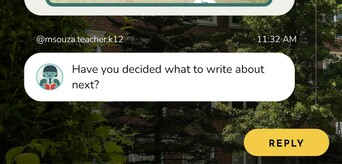
Messaging with Mr. Souza and the Tipster
The journalism teacher Mr. Souza will share tips and insights from the anonymous tipster along the way. To reply to his messages and move forward, click “Reply
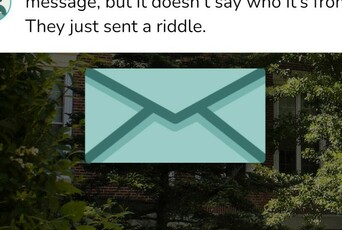
Riddles
To open riddles from the Tipster, click the blue envelope. Click “back” to return to the story the click “reply” to continue.
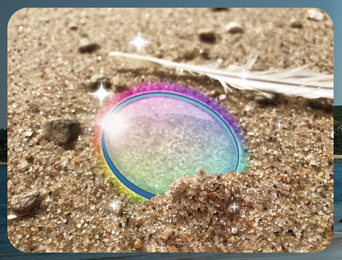
Magic Seaglass
Your magic seaglass will help the player transform the modern landscape and see what Plymouth and Patuxet looked like in the 1600s. Click “CONTINUE” to move to the next scene.
Navigating the Map
The player can choose each of the four locations and activities to explore in order after the first activity. They can also explore a fifth secret location (Plimoth Patuxet Museums) which requires a password. Players will collect pieces of the password when solve a puzzle at each location and unlock part of the secret password. Click a location and select “GO” to begin.

Picking up where you left off?
If you have already started the game with your students or would like to skip the introduction and move ahead to the first activity, you can click “go to map” on the Home Screen and choose which activity you would like to explore. Click on a location and then click “GO” to travel there. You can also click the map icon at any time to go back to the map.
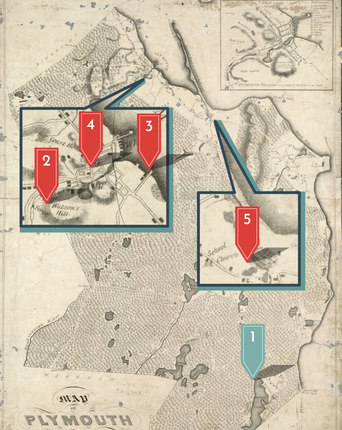
Activity #1 - Stratigraphy Sort
Recommended playing time: 10-12 minutes
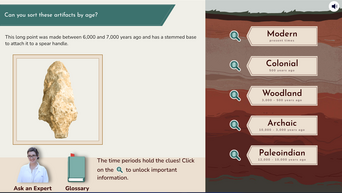
How to play: Look at the artifact and read the clues to figure out in which time period the artifact was made. Click on the time period to make your hypothesis. If you guess incorrectly, you`ll get another try.
Need more clues to figure out when each artifact was made? Click on the magnifying glass to hear from an expert.
Click on “Ask an Expert” to learn more about archaeology and how it helps us understand the past.
Activity #2 - Document Decoder: A Mutual Alliance of Protection
Recommended playing time: 10-12 minutes
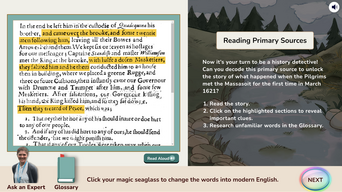
Click on a highlighted section to learn more about what’s happening.
Ready to translate the document into modern English? Click on the magic seaglass.
Click here to pause the document being read aloud. Click “play” to resume.
Lost in Translation!
Recommended playing time: 5-10 minutes
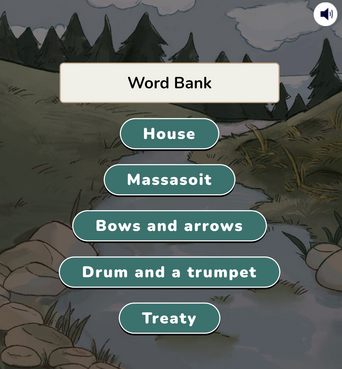
How to play: Use the word bank to fill in the blanks and solve the mystery of what happened in March 1621. When you choose the right answer, click “NEXT” to continue. If you guess incorrectly, click “TRY AGAIN.”
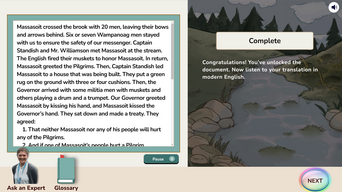
When you finish filling in the missing pieces of the document, click “NEXT” to hear the new, modern translation read aloud.
Activity #3: Pilgrim or Indigenous?
Recommended playing time: 8-10 minutes
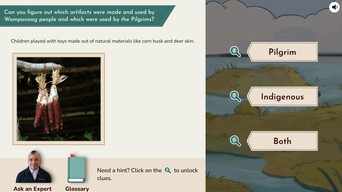
When you have determined which culture made or used the artifact, click on the corresponding button. If you guessed correctly, click “NEXT” to move on. If you guess incorrectly, click “TRY AGAIN.”
Activity #4: Document Decoder - the 1621 harvest celebration
Recommended playing time: 10-12 minutes
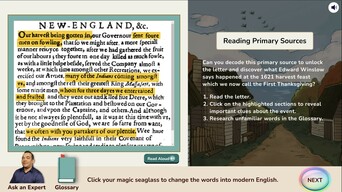
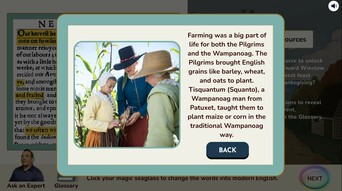
Click on a highlighted section to learn more about what’s happening.
Click here to pause the document being read aloud. Click “play” to resume.
Ready to translate the document into modern English? Click on the magic seaglass.
Lost in Translation!
Recommended playing time: 5-10 minutes
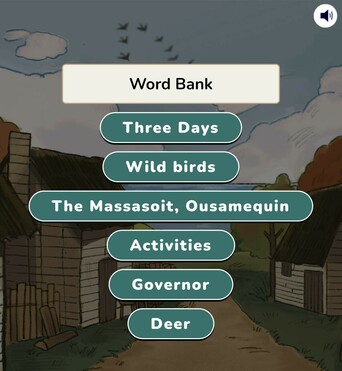
Use the word bank to fill in the blanks and solve the mystery of what happened in 1621. When you choose the right answer, click “NEXT” to continue. If you guess incorrectly, click “TRY AGAIN.”

When you finish filling in the missing pieces of the document, click “NEXT” to hear the new, modern translation read aloud.
You did it! Unlock the 5th Location
Entering the Passwords
When your students have completed all four activities, they can unlock the 5th location with the passwords they earned after completing each challenge. Want to see what you are typing? Click the “eye” icon to reveal the text.
If you are using the game over multiple class periods, you may need to remind students of the password for each module.
The case-sensitive passwords are:
Module #1: corn
Module #2: deer
Module #3: pumpkin
Module #4: pig
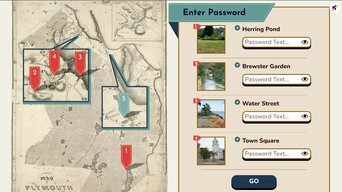
When you have entered all the passwords correctly, click NEXT.
Student Reporting Activity Option
Students can work in groups, pairs, or independently to review the key takeaways from the four activities and learn more about the 1621 harvest feast from various Museum staff, tribal historians, and cultural expects.
Students can choose to add information they learned about the harvest feast we now call The First Thanksgiving either during the game or as part of a unit, lesson, workshop, or field trip to Plimoth Patuxet Museums.
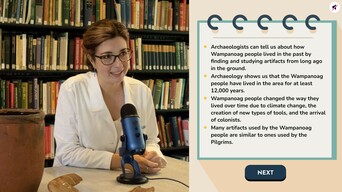
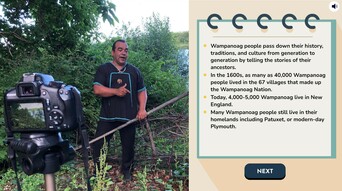
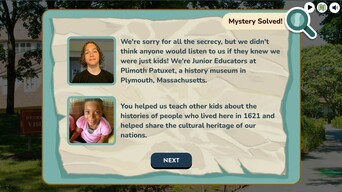
The Mysterious Tipsters
When students complete the game and report out on what they learned, the mysterious tipsters reveal themselves and share why sharing stories from the past is important to them and their communities.
Consider asking students: Why is understanding what happened in the past important in our lives today?
Congratulations!
When students complete the entire game, they can customize and print their own History Detective Award.
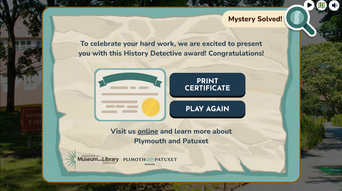
Click PRINT CERTIFICATE to add students’ names - or - click PLAY AGAIN to return to the map.